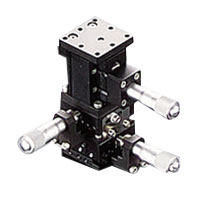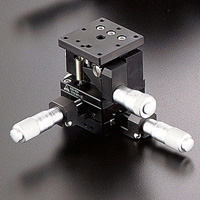(!)NOTE : Windows 7 users won’t be able to use some latest features of eCatalog/WOS since Microsoft is ending support for Windows 7 on 14 Jan, 2020. Please upgrade your system for uninterrupted services.
- Notice of End of Sales for Economy Series Pneumatic Equipment Category. More information.
Manual XYZ-Axis Stages(Table Size (Thickness) H (Range Selectable):60.1~70)
Brand |
|
|---|---|
| CAD |
|
| Days to Ship |
|
2 items
- Sort By
-
You can add up to 6 items per a category to the compare list.

Horizontal Surface XYZ-Axis Crossed Roller Guide Stage
SURUGA SEIKI
[Features]
· A type that combines the XY-axis and Z-axis of the cross roller guide.
· You can choose either center operation or side operation for the micrometer.
· A reversed type is also available.Z-Axis Stage Surface Table Size (Length) L (Range Selectable)(mm) Table Size (Width) W (Range Selectable)(mm) Load Capacity (Range Selectable)(N) Table Size (Thickness) H (Range Selectable)(mm) Stroke (Distance along X-Axis) (Range Selectable)(mm) Travel Guide Feeding Method Stroke (Distance along Y-Axis) (Range Selectable)(mm) Stroke (Distance along Z-Axis) (Range Selectable)(mm) Table Material Table Surface Treatment Horizontal ~25 ~25 1~4.9 60.1~70 Up to ±10mm Cross Roller Micrometer Head Up to ±10mm Up to ±10mm Aluminum Black Anodize From: ₹ 90,605.16 Days to Ship: 5 Day(s) or more  5 Day(s) or more
5 Day(s) or more
-
You can add up to 6 items per a category to the compare list.

Horizontal Surface, Thin-Type, XYZ-Axis Crossed Roller Guide Stage
SURUGA SEIKI
A cross roller stage type that combines the thin XY-axis with the Z axis. *The CAD data for this series is being revised. It will be available as soon as modifications are complete.
Z-Axis Stage Surface Table Size (Length) L (Range Selectable)(mm) Table Size (Width) W (Range Selectable)(mm) Load Capacity (Range Selectable)(N) Table Size (Thickness) H (Range Selectable)(mm) Stroke (Distance along X-Axis) (Range Selectable)(mm) Travel Guide Feeding Method Stroke (Distance along Y-Axis) (Range Selectable)(mm) Stroke (Distance along Z-Axis) (Range Selectable)(mm) Table Material Table Surface Treatment Horizontal 26~40 ~ 41~60 26~40 ~ 41~60 5~30 60.1~70 Up to ±10mm Cross Roller Micrometer Head Up to ±10mm Up to ±10mm Aluminum Black Anodize From: ₹ 104,635.95 Days to Ship: 5 Day(s) or more  5 Day(s) or more
5 Day(s) or more
| Brand |
|---|
| Product Series |
| CAD |
| From |
| Days to Ship |
| Z-Axis Stage Surface |
| Table Size (Length) L (Range Selectable)(mm) |
| Table Size (Width) W (Range Selectable)(mm) |
| Load Capacity (Range Selectable)(N) |
| Table Size (Thickness) H (Range Selectable)(mm) |
| Stroke (Distance along X-Axis) (Range Selectable)(mm) |
| Travel Guide |
| Feeding Method |
| Stroke (Distance along Y-Axis) (Range Selectable)(mm) |
| Stroke (Distance along Z-Axis) (Range Selectable)(mm) |
| Table Material |
| Table Surface Treatment |
You can add up to 6 items per a category to the compare list. | You can add up to 6 items per a category to the compare list. | |
| Brand | SURUGA SEIKI | SURUGA SEIKI |
| Product Series | Horizontal Surface, Thin-Type, XYZ-Axis Crossed Roller Guide Stage | |
| CAD |
|
|
| From | ₹ 90,605.16 | ₹ 104,635.95 |
| Days to Ship | 5 Day(s) or more | 5 Day(s) or more |
| Z-Axis Stage Surface | Horizontal | Horizontal |
| Table Size (Length) L (Range Selectable)(mm) | ~25 | 26~40 ~ 41~60 |
| Table Size (Width) W (Range Selectable)(mm) | ~25 | 26~40 ~ 41~60 |
| Load Capacity (Range Selectable)(N) | 1~4.9 | 5~30 |
| Table Size (Thickness) H (Range Selectable)(mm) | 60.1~70 | 60.1~70 |
| Stroke (Distance along X-Axis) (Range Selectable)(mm) | Up to ±10mm | Up to ±10mm |
| Travel Guide | Cross Roller | Cross Roller |
| Feeding Method | Micrometer Head | Micrometer Head |
| Stroke (Distance along Y-Axis) (Range Selectable)(mm) | Up to ±10mm | Up to ±10mm |
| Stroke (Distance along Z-Axis) (Range Selectable)(mm) | Up to ±10mm | Up to ±10mm |
| Table Material | Aluminum | Aluminum |
| Table Surface Treatment | Black Anodize | Black Anodize |
Loading...
Configure
Specification/Dimensions
-
Z-Axis Stage Surface
- Horizontal
- Vertical
-
Table Size (Length) L (Range Selectable)(mm)
-
Table Size (Width) W (Range Selectable)(mm)
-
Load Capacity (Range Selectable)(N)
- 1~4.9
- 5~30
- 30.1~50
-
Table Size (Thickness) H (Range Selectable)(mm)
-
Stroke (Distance along X-Axis) (Range Selectable)(mm)
-
Travel Guide
- Dovetail Slide
- Cross Roller
- Linear Ball
- Dovetail Slide, Feed Screw
- Dovetail Slide, Rack & Pinion
-
Feeding Method
- Rack & Pinion
- Feed Screw
- Micrometer Head
- Rack & Pinion Feed Screw Complex Type
-
Stroke (Distance along Y-Axis) (Range Selectable)(mm)
-
Stroke (Distance along Z-Axis) (Range Selectable)(mm)
-
Table Material
- Steel
- Stainless Steel
- Aluminum
- Brass
- Aluminum Alloy
-
Table Surface Treatment
- Black Anodize
- Black Oxide
- Electroless Nickel Plating
- Low Temperature Black Chrome Plating
- Black Fluoro Resin
Related Categories to Manual XYZ-Axis Stages
FAQ Manual XYZ-Axis Stages
- Question: What specifications should I consider when selecting a Manual XYZ-Axis Stage?
- Answer: When selecting a Manual XYZ-Axis Stage, consider the following specifications:
- Travel Range: Ensure the stage's travel range meets your application needs.
- Resolution: Look for stages with fine resolution to achieve precise movements.
- Load Capacity: Determine the maximum load the stage can handle for your specific application.
- Accuracy: Check the accuracy of the stage to ensure it meets your precision requirements.
- Drive Mechanism: Understand the type of drive mechanism (manual adjustment, lead screw, etc.) and choose based on your preferences and application. - Question: How does the stroke distance along the X, Y, and Z axes impact the stage's functionality?
- Answer: The stroke distance, or travel range, along the X, Y, and Z axes directly affects the stage's functionality. A larger stroke allows for a broader range of movements and flexibility in positioning. Ensure the stage's stroke distance accommodates the size of your workpiece and the required range of motion for your application.
- Question: What types of table materials are available for Manual XYZ-Axis Stages?
- Answer: Manual XYZ-Axis Stages commonly have tables made of materials like aluminum, stainless steel, or cast iron. Aluminum is lightweight and suitable for general applications, while stainless steel offers corrosion resistance. Cast iron is chosen for heavy-duty applications. Select the material based on the environmental conditions and the load requirements of your specific application.
- Question: What surface treatments are used for XYZ-Axis Stages, and why?
- Answer: Common surface treatments include anodizing for aluminum stages and coatings like black oxide or nickel plating for steel stages. These treatments enhance durability, corrosion resistance, and reduce friction. Choose the surface treatment based on the material of the stage and the environmental conditions of your working environment.
- Question: How can I compare and select the right Manual XYZ-Axis Stage for my needs?
- Answer: To select the right Manual XYZ-Axis Stage, compare specifications such as travel range, load capacity, accuracy, and material. Consider your application requirements, workspace constraints, and budget. Look for user reviews or consult with experienced colleagues to gather practical insights.
- Question: How do I determine the appropriate load capacity for my Manual XYZ-Axis Stage?
- Answer: Determine the load capacity by summing the weights of your workpiece and any additional equipment. Choose a stage with a load capacity slightly higher than your calculated value to ensure safety and optimal performance. It's crucial to account for potential future modifications or additions to your setup.
- Question: What kind of work are Manual XYZ-Axis Stages typically used for?
- Answer: Manual XYZ-Axis Stages are commonly used for tasks requiring precise positioning and alignment in various industries such as electronics, optics, and research. They are ideal for tasks like assembling components, inspecting small parts, or positioning tools accurately. Their versatility makes them suitable for applications where controlled and manual adjustments are necessary.







How can we improve?
How can we improve?
Thank you for your time.
Your feedback is essential for our continuous improvement
Privacy Policy
Thank you for your cooperation.
Thank you for your time.
Your feedback is essential for our continuous improvement
Please use the inquiry form.
Privacy Policy